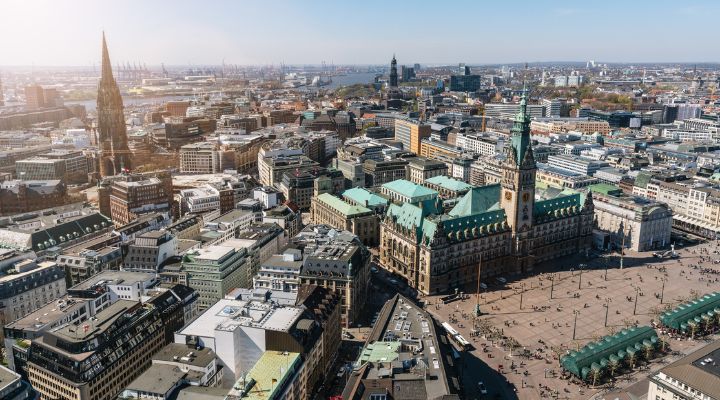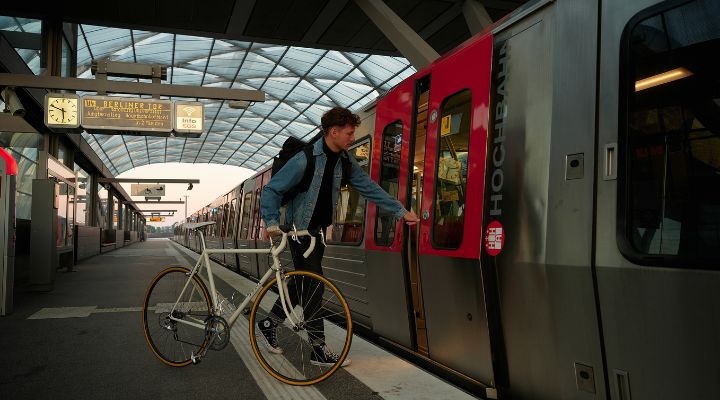Loading component...
Get up to speed on the mobility industry - our newsletter straight to your inbox!
Get up to speed on the mobility industry - our newsletter straight to your inbox!
Anjes Tjarks (AT): If I can put it into two words, it's ‘less cars’. If I make it six words, it's ‘less cars driving on the streets’. If we look back to the year 2000, we now have 17% less cars driving on our city streets. So the mobility transition, in this sense, is actually happening and it means more room for other modes of traffic. By that I mean pedestrians and cyclists, but also for buses, for green streets, and for a more liveable city. If you look at this development, you can see the transition. It’s also notable that during the same timespan, the city’s population grew by 10%. So we have 10% more people, but 17% less individual traffic and that's the difference.
If you combine these two things together, then the mobility transition is also a method of enhancing the life of people who need to or want to drive a car. Because the mobility transition in itself says that the average person needs less space between two blocks in a city, or two blocks in the street, and therefore, those who need most space, the cars, can flow even better.

Hamburg Main Station by Jörg Modrow
In Hamburg the mobility transition isn’t just pedestrians and cyclists, it’s also includes buses, green streets and a more liveable city. If you look at this development, you can see the transition
AT: I think the most prominent option in terms of sustainability is the Deutschlandticket, or D-Ticket. With the D-Ticket we have the ability to cut transport costs in half. Previously travellers paid on average around €96 per month on travel and with the D-Ticket it’s capped at €49. As the name suggests it’s valid across the whole country. In the Hamburg area, not just the city, we have had an additional 400,000 subscriptions. We grew from about 700,000 subscriptions to 1.1 million - around 43% of Hamburg’s population have a D-ticket ticket now. This will increase by another 200,000 because from September this year all school students will be eligible for a free Deutschlandticket.
AT: I'm not sure if everybody in my city would say that we're fulfilling this obligation but our philosophy is ‘a mobility transition for everybody’. We need to look at the needs of every person. Let’s take cycling as an example: in the Netherlands you have safe intersections and safe cycling lanes. This is new to Germany. It makes cycling attractive for people of all ages, from six to 99.

Hamburg cityscape by RClassenLayouts
In Hamburg the mobility transition operates with a very diverse agenda. For instance, does everybody feel safe on public transport? When I took office four years ago, we had four taxis that were wheelchair accessible. Four. Now we have 58 and 54 of them are electric. Another aspect is the ALIKE driverless ride-pooling service, including the on-demand service MOIA, that aims to have 10,000 autonomous shuttles on Hamburg’s roads by 2030.
The ALIKE project will create a booking system for up to 20 driverless vehicles in our city, bridging the gap between public and individual transport. We are creating an entirely new pillar of public transport as an attractive alternative to the private car.
When I took office four years ago, we had four taxis that were wheelchair accessible. Four. Now we have 58 and 54 of them are electric
Moia has 10,000, virtual stops in Hamburg. Disabled travellers now have a free, almost point-to-point service. This is what I mean by the mobility transition being for everybody. The problem is that there are so many “everybodys” it’s very difficult to meet all their needs and to make this a political success, but this is the philosophy behind it.

Elbphilharmonie Hamburg by Sascha_B_Hamburg
AT: First of all, I think we can learn from any city. Second, obviously, the cities that are culturally close to us, meaning European cities, and then to narrow it further down, also German-speaking cities, we can learn a bit more from because we have the same reference and more or less the same traditions. Vienna is a good example of where we can learn from each other. Vienna is obviously a German-speaking city, it’s roughly the same size and it’s governed by the Social Democrats since World War Two. Two other cities that are close to us, Copenhagen and Rotterdam, would also be similar in geographical respects. But we also need to look in other world regions, because other world regions have a different developmental speed.
In terms of public transport, I look at Asia, especially, but also at the Arabic world. Not that everything is perfect there, but you just need to look at the new investments and you'll see what I mean. In Europe, there has hardly been any new subway systems built in the last 30 years, yet in Riyadh they appear to be building six subways at the same time! Imagine having a brand new underground transport system and not one that is over 100 years old? I truly believe that we are able to showcase some stuff for the world but we also need to be aware that we can learn from more or less all cities, but we need to not cherry-pick.

Elbbrücken Station by Christian Brandes
In Europe, there has hardly been any new subway systems built in the last 30 years, yet in Riyadh they appear to be building six at the same time! Imagine having a brand new underground transport system…
AT: That’s a nice concept, but I think traffic will be an ongoing forever. What I would like to point out, though, is that we are following four main ideas that will enable us to make the mobility transition we’ve been talking about.
The first is the traffic flow issue, and we have covered that. The second is an infrastructural issue. We need to maintain our infrastructure, and also scale it up. I need to upgrade 11 new bridges over our two rivers between now and 2040. These old bridges are all 300 to 400 metres long and in need of repair. That’s an illustration of the scale of that task.
The third main topic I'm following is to reduce pollution and co2 emissions to improve Hamburg’s air quality. We have the highest quality drinking water in Europe but if our air was the water no one would drink it. We meet the European standards, but it's not good enough, so pollution is a serious issue. It’s also a societal issue because people feel that it is their right to drive everywhere. The argument being that the average person has to live in the suburbs because they can’t afford to live in the city. There is truth in this, of course, but there's also a counter argument as they are polluting the city on their way to and from their place of work.
We have the highest quality drinking water in Europe, but if our air was the water no one would drink it. We meet European air quality standards, but it's not good enough, so pollution is a very big issue